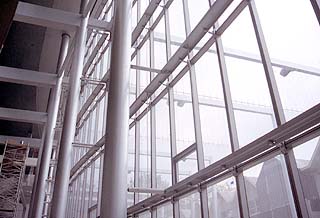|
Subscribe / Renew |
|
|
Contact Us |
|
| ► Subscribe to our Free Weekly Newsletter | |
| home | Welcome, sign in or click here to subscribe. | login |
Architecture & Engineering
| |
 |
June 5, 2003
A centerpiece for Seattle Center
Seattle Center

Photo by Michael Dickter, MKA
A five-story serpentine glass façade provides a grand entrance to the hall.
|
Seattle Center is a 74-acre campus enjoyed by more than 10 million visitors each year. Home to world-class performing arts groups, major sports teams and attractions, it features some of the city’s most recognized architecture.
From the towering Space Needle to the Frank Gehry-designed Experience Music Project, Seattle Center spans the decades creating architecture that connects both the passerby and patron with the space around them.
Marion Oliver McCaw Hall is the centerpiece of this vision — engaging the entire community with its public promenade and eye-catching design. What adds even more to its dramatic architecture are the opportunities for the community to celebrate and congregate there.
Whether you are attending a performance or a more intimate reception, the major design objective of McCaw Hall is to engage the entire community while honoring the patron it serves.
You don’t need a ticket to experience the drama. Designed to incorporate a theatrical experience from the outside-in, it is nothing like the blank brick façade of its predecessor with chained doors when not in use.
Today, a five-story serpentine glass façade provides a stunning entrance to the hall as it faces a public promenade that connects Mercer Street to the heart of the Seattle Center campus.
With 372 panes of the clearest glass, the five-story façade and promenade are designed as a theatrical threshold, lined with a field of three-dimensional metal scrims. During the evening hours, compositions of choreographed color and light are projected on and through the scrims to cast a series of visual melodies, bathing a passerby in colored lights as they become immersed in the art.
A look inside
Inside the hall features a grand staircase that leads to a 12,000-square-foot grand lobby. Two additional balcony levels are accessible by elevator or stairways and include open spaces with views of the hall, scrims and the Seattle Center campus.
The colors and materials of the lobby take their inspiration from the beauty of Northwest skies, creating a union between the light that baths the hall through the glass wall and the interior spaces. As local artists have noted, the clouds, moisture and northern latitude of the Northwest create “oyster-shell” skies, a luminous, silvery quality reminiscent of the inside of an oyster-shell.
This reflective quality is captured in the hall’s shimmering interiors, which are created with 132 colors taken from the palette of the Northern light, those sumptuous sunset hues. The effect has created interiors that subtly react to changes in the outside light and the rhythm of the scrims. Again, blurring the lines between indoor and outdoor spaces.
Amenities
Each lobby has concessions, family restrooms, and women’s and men’s restrooms on each side of the lobby. The lobbies are designed as the perfect setting during intermission or host private and corporate events including weddings, receptions and banquets. In addition, two upper level reception rooms afford a greater level of privacy hosting banquets of 100-150 or receptions for 250-300 guests.
Inside the Susan Brotman Auditorium, design modifications have significantly reconfigured the 2,900-seat auditorium to improve sight lines, acoustics and create a more intimate relationship between the artists and audience.
The walls of the auditorium have been moved in 15 feet on each side, reducing the total width by 30 feet in order to create two new rows of box seats on each side. There are a total of 16 new boxes, eight on each sidewall with seats that face the stage, not the auditorium.
New gallery seating connects the first balcony to the orchestra level with seating tiers rising along the sides of the room. Together, the narrowed walls, elevated galleries, side boxes and extended balconies give audience members a more intimate relationship with the performers.
Although not visible to the general public, the backstage changes are as dramatic as the public spaces. The new stage will feature a proscenium opening that is 10 feet taller, making the stage more of a square than rectangle.
This change allows more flexibility with sets, bringing the hall in line with European standards for proscenium height. The stage now has a state-of-art rigging system and a sophisticated trap door system. In addition, the fly loft has been raised to 100 feet to completely pull the scenery out of view when the in the “up” position over the stage.
New lecture hall
Another new feature is the 400-seat Nesholm Family Lecture Hall with a raked floor, built-in video/DVD system, and modern sound and lighting equipment. It can equally host lectures, readings and multi-media events.
The hall is designed by Jaffe Holden Acoustics, the same acousticians that engineered the auditorium. With its own lobby, restrooms and entrance, the lecture hall is a prime location for speaking engagements, presentations and films.
On the south side of the lobby, Café Impromptu awaits diners with an indoor seating capacity of 160 and an outdoor foyer for 40. Catering and concessions for the cafe are provided by The Westin Seattle.
Visitors can enter the promenade lobby even when there is no performance in the hall, Wednesdays through Sundays, 11 a.m.-5 p.m.
Virginia Anderson is the director of Seattle Center. For booking information on McCaw Hall rental spaces, contact Seattle Center event sales at (206) 684-7202 or eventsales.seattlecenter@seattle.gov.
Other Stories:
- Demolition crews keep danger at bay
- At McCaw Hall, the performance begins outside
- Bracing for a new future
- A breath of fresh air


